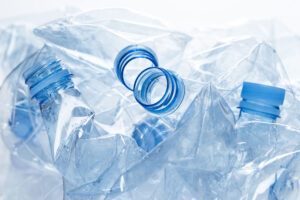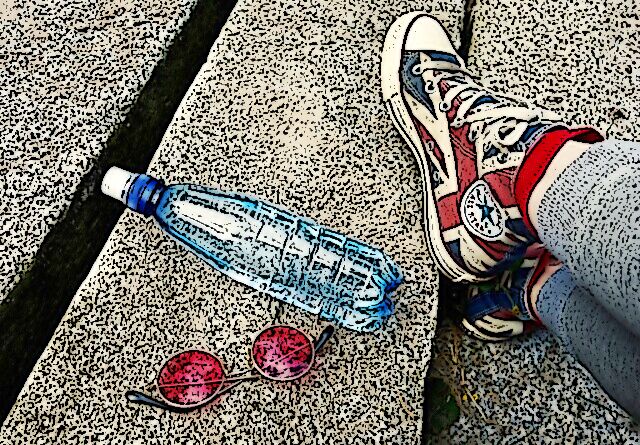Learn more about PET
PET (or PETE, PETP, PET-P) is polyethylene (or polyethylene) terephthalate. A form of polyester is a plastic resin made from a combination of two monomers, ethylene glycol and purified terephthalic acid.
Virgin PET is made through the extraction of crude oil and natural gas from the earth’s core. It is heated to form a molten liquid, then molded and solidified to form PET plastic containers.
It is the most recycled plastic worldwide, as it is accepted by many waste management systems. PET is also easy to identify for recycling through clear embossing and good labeling. Regularly used for soda bottles, water bottles and food jars.
Biaxial stretch
By both stretching and blowing, the rPET is moved in two directions. This method is responsible for imparting glass-like clarity to rPET while having excellent barrier properties and strength.
Intrinsic Viscosity (IV) in PET
IV is a measure of the molecular weight of polymers, indicating the strength and functionality of PET. The higher the IV, the better the tensile strength, the higher the melting point and the lower the freezing point, so high IV is best.
The qualities and benefits of PET bottles and jars
All of the following qualities and benefits of using PET also apply to rPET, first bar: 100% pure rPET bottles may have a slightly cloudy appearance due to impurities and lower IV. This might be an acceptable trade-off for consumers, but if not, it could easily be remedied by using a slightly less sustainable blend of rPET and PET.
Unbreakable: ideal for use in environments where glass can be a potential hazard, such as bathrooms, kitchens and retailers, perfect for on-the-go consumption
Good Barrier properties mean a longer shelf life: PET packaging has excellent gas and moisture barrier properties and is resistant to the penetration of microorganisms and O2, meaning it can hold food and beverages and products containing oxygen or carbon dioxide, alcohols, oils and diluted . Acid freshness for longer compared to other plastics
Lightweight: 10% of the weight of equivalent glass packaging, meaning it’s easy to use and incredibly efficient to transport, therefore reducing carbon emissions
Transparent: Same clarity and attractiveness as glass packaging for viewing contents
Thermostable: The most common cold-filled PET bottles and jars can withstand temperatures between -40 and 60 degrees Celsius. If using the CPET or double ISBM process, it is possible to make hot fill bottles that can withstand the heat of a conventional oven up to 230 degrees Celsius. PET also has a higher heat distortion temperature (HDT) than other plastics.
Reusable, resealable and fully recyclable: Bottles and jars can be reused and polymer reprocessed into granules and reintroduced into the original supply chain to create new PET raw material
Easily recyclable: It is widely accepted by recycling facilities across Europe and is easy to distinguish with its #1 recycling embossing and label: 90% of Virgin PET is recycled in countries like Finland.
More sustainable than other plastics: PET has a lower production carbon footprint than other plastics
Customizable: It can be created in many non-circular shapes and varying volumes, especially with the One-Stage injection molding process.
Inexpensive: There is a high supply of PET and therefore less costly than other plastic
PET and Glass
- pros
- PET is up to 40 times lighter than glass
- PET is 5 times cheaper than glass
- PET is more durable than glass because it is unbreakable.
- PET is safer as it does not form microbial biofilms, including glass-like harmful bacteria, fungi and protists.
- PET production process is better for the environment than glass production
- cons
- Glass may be clearer, but high-end PET may have a glass-like appearance
- PET uses glass sand to extract crude oil from the ground.
Analysis shows that PET as a packaging material has a lower overall environmental impact, largely due to the weight of the glass. PET is much lighter and uses much less CO2 for shipping. Also, PET is fully recyclable (like glass) and unbreakable, so production results in a much higher level of used product and much less breakage/damage.
PET and Aluminum
- pros
- With a 330 ml PET bottle and a 330 g PET bottle with an aluminum can of the same size using 1300 g CO2 emissions, PET uses half the amount of greenhouse gases to produce from aluminum.
- PET costs 20-30% less than aluminum
- PET is more convenient for the consumer as it is reclosable whereas cans cannot be closed
- PET has more options for shapes, volumes and colors
- PET production has more infrastructure, so production cost is lower than tin cans.
- cons
- Less power required to cool aluminum cans than PET bottles
- Because they are very light, less space is required to transport aluminum cans than PET bottles.
Given the CO2 emissions from aluminum production, food and beverage waste from non-resealable packaging, and the cost of replacing many production infrastructures, PET is a much more sustainable choice.
Elif Güray Kayaduman – Pet Recycling Consultancy

What is rPET?
rPET is recycled polyethylene terephthalate. The most significant impact of rPET is in its creation: It reduces greenhouse gas emissions by 71% compared to Virgin PET and requires 79% less energy to produce. This gives rPET a much smaller carbon footprint at 2.15 CO2 per kg versus 0.45 CO2 per kg, less than a quarter of regular PET. rPET bottle and jar production grew by 29.5% in 2017.
rPET is produced by collecting and sorting industrial waste and post-consumer PET, flaking the material, then cleaning and drying it to form a granule that can be converted into new products. rPET can be produced in two ways:
Post Consumer
It refers to PET that has been used before being discarded by consumers. It can be collected from recycling bins, the ocean or landfills. Post-consumer recycling is effective in removing plastic from the environment and is reprocessed to form rPET.
post-industrial
It is PET collected as waste during the production process. This is reusable and makes production more efficient and sustainable. It is also reprocessed to create rPET.
benefits of rPET
rPET has all the benefits of PET bottles and jars with some added extras. From a business perspective, adding more rPET to packaging means a business can identify with a wider customer base and increase its sales by responding to the demand for recycled packaging and sustainable efforts. In addition, the use of rPET leads to greater demand and market for recycled plastics, which will increase material supply and reduce costs – a win-win for business and the environment.
Besides having all the advantages of pure PET bottles – rPET has many environmental benefits:
Uses 79% less energy and less water to produce than pure PET
Transport reduces carbon emissions: as demand grows, so does a more local and reliable supply of rPET, limiting the need to transport rPET internationally
Less plastic goes to landfill: No toxic chemicals leak into groundwater over the years that need to be broken down, through recycling and stopping material going into landfills
Reducing the need to extract resources from the earth by eliminating the need to create new PET using rPET offsets
Promote bottle return schemes and post-consumer recycling programs and make them the norm in the industry – will be prevented from spilling into the ocean.
Lowering costs – consumer demand for recycled materials has increased, thus pushing the prices and shipping costs down, while a focus on good design means reducing costs and waste by reducing the amount of plastic used in the bottle and jar manufacturing process.
Meeting consumer demand for recycled packaging, increasing sales and reducing costs by advancing the recycled materials market.
Source : https://embaco.com/
